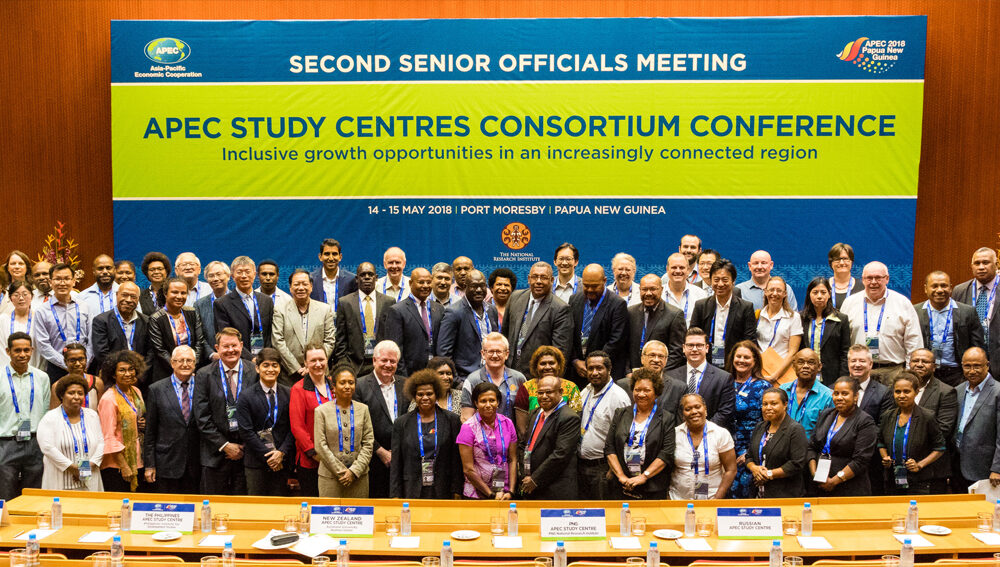According to its mission statement, APEC is the premier Asia-Pacific economic forum, whose primary goal is to support sustainable economic growth and prosperity in the Asia-Pacific. APEC’s membership includes advanced, emerging and developing economies, with major differences in levels of economic development and living standards across the region. Over 70 per cent of Australia’s trade is with other highly diverse APEC countries.
PNG is the APEC host country for 2018, and with a population around 8 million, is one the most culturally diverse in the world, having over 800 languages and hundreds of indigenous ethnic groups. With GDP per capita under $4,000 and currently experiencing economic growth around 3 per cent per annum, PNG is a developing economy member of APEC, which it joined in 1993.
The APEC Study Centre Consortium (ASCC) is a group of more than 50 institutions undertaking research, capacity building and community outreach in support of APEC goals for regional economic integration and inclusive economic growth.
The APEC Study Centre within the Griffith Asia Institute represented Australia at the 14-15 May ASCC conference (ASCCC18) held in Port Moresby. As in recent years, the conference was convened in conjunction with the Senior APEC Officials Meeting in the lead-up to the APEC economies Leaders’ Meeting in Port Moresby in mid-November.
The objective of ASCCC18 was to inject new ideas based on sound economic research and analysis that could improve public policy oriented to lifting the economic welfare of people in the Asia-Pacific region. From 74 submissions from the 21 APEC member economies to present at ASCCC18, only 25 papers were selected.
The theme of the conference was “Inclusive growth opportunities in an increasingly connected region” and included four sub themes:
- Regional economic integration and connectivity;
- Structural reform and competition;
- Digitalization; and
- Innovation and technology.
The Griffith ASC presentation focused on the concept of international competitiveness which determines how well economies perform in the international economic arena. Measures of competitiveness reflect an economy’s ability to sell goods and services to the rest of the world and to compete against goods and services produced abroad. Conventional price-based measures of competitiveness differ from productivity measures which gauge how efficiently the economy’s inputs of labour, capital and technology combine to produce these goods and services. Economies that are highly competitive and productive experience higher economic growth rates per head which improves the overall living standards of its citizens.
There are several different ways to gauge an economy’s competitiveness. The focus was on three key measures – the real exchange rate, the ratio of the prices of non-tradable to tradable goods and services, and the more multi-dimensional World Economic Forum approach. First, the real exchange rate has traditionally been used to convey the degree to which domestic producers can compete on price grounds with suppliers of goods and services in other economies.
Second, an alternative exchange rate based measure is proposed based on the relative prices of non-tradables to tradables. From a production perspective, if this measure is rising, labour and capital will be drawn away from the tradable sector for deployment in the non-tradable sector. Hence a diminishing share of the economy’s output will be exposed to international competition, other things the same.
In other words, labour and capital inputs will be drawn away from industries competing on world markets to produce goods and services for home consumption and which do not enter into world trade. The result is de-internationalisation of the economy’s production. At the same time, domestic consumption of relatively cheaper tradables will increase, thereby adding to the import bill and widening the trade deficit. Third, a broader competitiveness measure published annually by the World Economic Forum (WEF) has a productivity dimension.
This presentation canvassed ways in which economic reform via fiscal and structural measures, including those affecting labour markets, could improve competitiveness according to these measures, with particular reference to Australia’s experience since 2000 as a case study.
Professor Tony Makin is Director Australia APEC Study Centre at Griffith University.








